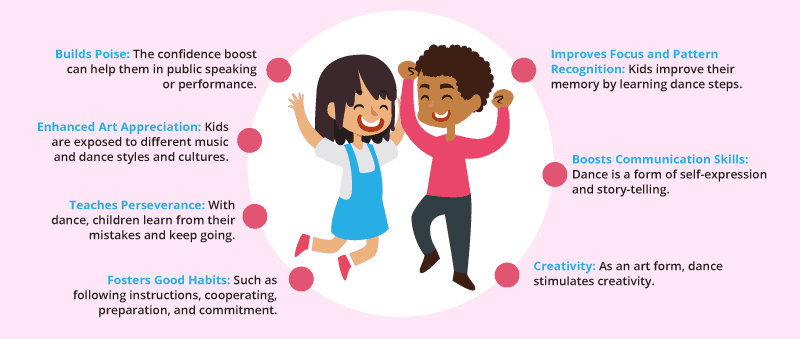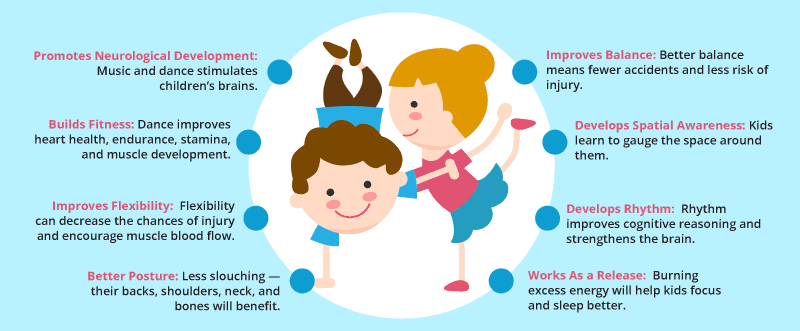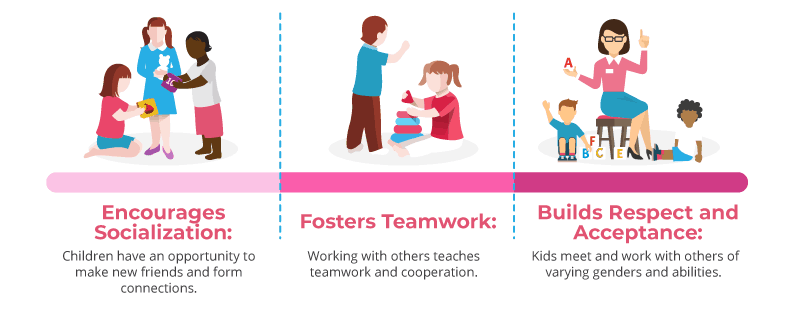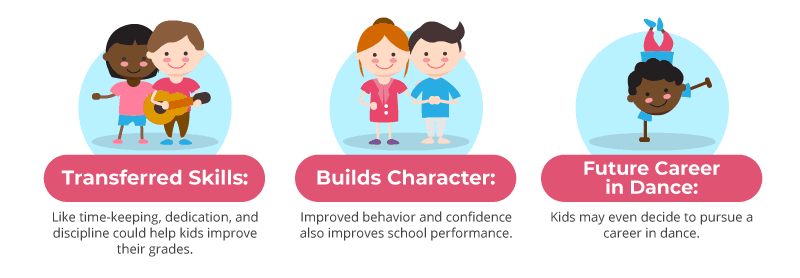Our Goal and Mission
Proudly offering quality dance classes in Ajax!
Creative Connexions Performing Arts Centre aims to bring an innovative but reliable experience of high-quality dance training at both the recreational and competitive level. We pride ourselves on offering a well-rounded arts education while creating professional opportunities for our students.
25 Impressive Benefits of Dance for Kids
Have you ever noticed that children love to dance? Creativity and self-expression are vital to your child’s well-being, and dancing is a fun way to get your child to be active.
Dancing has so many pros, from physical fitness to boosting confidence and creativity. But how do you encourage it?
Your child doesn’t have to become a master dancer, but there are too many advantages to ignore. Here’s how to get your child to reap the benefits of dancing.
Is Dance Education on the Decline?
Why has art taken a back seat in public education? It’s not just for those who want to excel in it, but for everyone.
Think about dance specifically. Surely you — assuming you’re not a professional — have gone dancing a few times. Dancing is something literally everyone can do.
Your child can dance for fun. If your child enjoys dance as an activity at school, it’s likely going to be casual. Even at most dance studios, dance classes can be taken just for fun.
Even if your child takes up dance as an academic, competitive or career-based skill, it won’t mean that they’ll dedicate their life to dance. It’s no different from any other compulsory subject at school.
It’s much the same as teaching children science, even if they’re not destined to pursue a scientific career. Art is innately valuable and should be just as important as other social, scientific or practical subjects.
Our school system is based on the unfortunate belief that performance art has no place in children’s lives. But in today’s world, with YouTube, self-publishing, indie platforms, and social media, various art forms are on the rise.
So why, then, do they seem to be on the decline in education? Numerous studies have been done on dance and its impact on students in public schools. One such study claims that dance cannot even be sufficiently represented in national assessments due to a lack of information on its progress.
There’s still hope. Influencers are promoting dance at schools, and the evidence is blatant. Dance not only keeps your child physically fit, but can also improve their grades, behaviour, and mental health.
Think About It As A Sport
We’re not saying that your child has to dance professionally. Think of it as you would a sport. Not every child who participates in athletics will end up in the Olympics, but we still encourage them to participate.
Dance is the same. We want to emphasize that unlike the other art forms, dance is a physical activity. You’re about to see the many benefits it offers your child.
 Physical Benefits of Dance
Physical Benefits of Dance
Now you may understand that dance is just as much an exercise as it is an art. Let’s take a look at its health benefits.
- It promotes neurological development: When a child enjoys music and learns to dance to its rhythms, it stimulates their brain. This improves their cognitive abilities, as well as their neurological health (4).
- Dancing keeps your child fit: Your child can improve their endurance, stamina, and energy by dancing. It also encourages strength and muscle development. Let’s not forget that it’s cardio, so it keeps their hearts healthy, too. Since it’s expressive, it might be an excellent solution for children who have an aversion to exercise.
- Dance improves flexibility: Just look at ballerinas. Your child doesn’t have to become a contortionist, but dance can make them more supple. Flexibility can decrease the chances of injury. It also gives you a wider range of motion and improves blood flow to your muscles (5).
- Your child will carry themselves better: Dancing is excellent for your spine. Dancers are taught how to control their bodies to optimally support their own weight. If your child learns to dance, their posture will improve. They won’t slouch and their back, shoulders, neck, and bones will benefit.
- It improves balance: In line with the above, dancing also gives you better balance. Once you learn how to correctly hold yourself, your entire stance improves. This keeps you centered, and is also necessary for your muscles and back. If you’re more graceful, you’re less prone to accidents and injury.
- Spatial awareness is developed: Likewise, dance teaches spatial reasoning — something that not all children are accustomed to. When you dance, you learn to gauge the space around you. It works on your judgment and awareness as well.
- Dancing is rhythmic: You might think that rhythm is something you just feel or enjoy, but having a sense of it can improve your overall health. Like with music, it improves your cognitive reasoning, which in turn strengthens your brain (6). It also helps you stay relaxed, and improves your mental health.
- It’s a release: Dancing takes energy. Your child shouldn’t be dancing to the point of exhaustion, but it’s an outlet for pent up hyperactivity. This can also improve their sleep, focus, and routine.
Often, if your physical condition improves, your mental health is strengthened too. A strong body makes it easier to have a strong mind. Let’s look at the psychological advantages of dance.
- Dance boosts confidence: This is a no-brainer. If your child is welcomed into a group and is allowed to shine, they’ll feel good. Dancing allows your child to take the lead. They’ll grow accustomed to an audience, and their self-esteem will get a boost. This can help them in other areas, like public speaking or performance.
- Art appreciation: It’s only logical that if your child practices an art, their understanding of art itself will improve. This broadens their knowledge and tastes. Kids will be exposed to many different music styles and cultures in dance.
- It will keep your child motivated and inspired: As with any other sport or activity, your child will learn to persevere. One thing that is often overlooked is that dance will teach your child to learn from their mistakes and keep going. This in itself is a confidence booster.
- Good habits: Dance is based on routine. Your child will learn to be on time, to stick to their commitments, and to practice. There are other life skills that are taught too, like following instructions, cooperation, and preparation. They’ll also learn to be dedicated, and will take on a “work hard, play hard” attitude.
- Dance strengthens cognitive ability: I touched on this in the physical benefits, but these are mental traits too. Dance can build your child’s focus, concentration, memory, and pattern recognition. It can even teach problem solving and innovation. Once your child is comfortable enough to experiment they’ll probably start choreographing their own pieces.
- It can improve communication: With all of the cognitive benefits of dance, combined with the confidence boost, your child will become better at communication. Dance is a form of self-expression and story-telling. These skills will translate into other areas of their lives, like speech.
- Dance is creative: Here’s another one I don’t have to explain. Dance is an art. If your child participates in it they’ll stimulate their creativity. Dancers are always encouraged to freestyle. When your child learns to express themselves as an individual, their creativity will become a force to be reckoned with.
 Mental Benefits of Dance
Mental Benefits of Dance
Often, if your physical condition improves, your mental health is strengthened too. A strong body makes it easier to have a strong mind. Let’s look at the psychological advantages of dance.
- Dance boosts confidence: This is a no-brainer. If your child is welcomed into a group and is allowed to shine, they’ll feel good. Dancing allows your child to take the lead. They’ll grow accustomed to an audience, and their self-esteem will get a boost. This can help them in other areas, like public speaking or performance.
- Art appreciation: It’s only logical that if your child practices an art, their understanding of art itself will improve. This broadens their knowledge and tastes. Kids will be exposed to many different music styles and cultures in dance.
- It will keep your child motivated and inspired: As with any other sport or activity, your child will learn to persevere. One thing that is often overlooked is that dance will teach your child to learn from their mistakes and keep going. This in itself is a confidence booster.
- Good habits: Dance is based on routine. Your child will learn to be on time, to stick to their commitments, and to practice. There are other life skills that are taught too, like following instructions, cooperation, and preparation. They’ll also learn to be dedicated, and will take on a “work hard, play hard” attitude.
- Dance strengthens cognitive ability: I touched on this in the physical benefits, but these are mental traits too. Dance can build your child’s focus, concentration, memory, and pattern recognition. It can even teach problem solving and innovation. Once your child is comfortable enough to experiment they’ll probably start choreographing their own pieces.
- It can improve communication: With all of the cognitive benefits of dance, combined with the confidence boost, your child will become better at communication. Dance is a form of self-expression and story-telling. These skills will translate into other areas of their lives, like speech.
- Dance is creative: Here’s another one I don’t have to explain. Dance is an art. If your child participates in it they’ll stimulate their creativity. Dancers are always encouraged to freestyle. When your child learns to express themselves as an individual, their creativity will become a force to be reckoned with.
 Emotional Benefits of Dance
Emotional Benefits of Dance
It’s all connected. If your child has a strong body that can host a strong mind, they’ll experience the world differently. Remember that we’re talking about art, something that has always been considered emotional, if not spiritual.
- Self-worth is improved: Think about how this can improve your child’s self-awareness. If they have something to be proud of, they’ll love themselves more. This could even be an important method of fighting bullying, depression, anxiety, and trauma. Dancing also teaches empathy, which has the potential to reduce these problems even more (7).
- Dance is fun: It sounds cheesy, but wouldn’t you rather have your child in a dance class than wasting away in front of a TV? Or falling in with the wrong crowd? Children don’t want to be bored. Dance can improve your child’s mood.
- Body language is emphasized: Dance can (and will) strengthen your child’s ability to communicate non-verbally. Not only will their body language improve, but they’ll also learn to read others better. This is a valuable life skill.
- It’s an emotional outlet: Everyone needs something they can pour their feelings into. Dance serves as a vent for your child’s emotional needs. Dancing is cathartic. It can greatly regulate your child’s behavior as well as their feelings. In doing so, it releases stress and built up frustration.
- Dance can keep your child on track: Any hobby or activity can give your child’s life more meaning. The motivation or desire to excel will give them a sense of purpose. Remember that even though your child doesn’t have to pursue dance professionally, it will open a door of opportunity if they want to. Simply put, it gives them something to work towards.
 Social Benefits of Dance
Social Benefits of Dance
Since dance is almost always a group activity, your child’s social awareness will pick up too. Public schools are notorious for invoking division among youngsters. Dance can help combat that.
- It’s a social activity: Dancing encourages socialization. Dance classes aren’t typically one on one. Your child will have an opportunity to make new friends. This will give them a place to fit in and feel connected to others. Dance teaches us to synchronize, which promotes empathy as well.
- There’s teamwork involved: This means that everyone has a part to play in a performance or routine, and this will foster a sense of teamwork and cooperation. When it’s not serious or professional, dance is not competitive. Everyone has their place and forms an important part of a bigger picture (8).
- Dance can teach respect and understanding: Dance doesn’t discriminate. Your child will be introduced to others of all walks of life. They’ll learn more about society and equality. Since there’s also an element of safe and structured physical contact, they’ll be taught to respect each other, too. They could even learn about different genders, identities, and sexualities.
 Academic Benefits of Dance
Academic Benefits of Dance
You’ve seen how dance improves a child’s physical, psychological, emotional, and social wellbeing. Now we can take a look at how they all tie together to benefit their academic performance (9).
- It’s practice: Everything that your child learns in a dance class, from discipline to routine to respect, can be applied in a classroom. This is a major advantage. If they learn time-keeping, dedication, and discipline, for example, their grades could improve. Dancing inspires them to work harder, which is sure to reflect in their schooling.
- It builds character: If dancing teaches your child better behavior and confidence, this will also show in their schooling. They’ll be more relaxed, confident, and outgoing. They’ll also learn how to follow instructions, respect themselves, their peers, and authority. Their demeanor will improve, and they’ll become better people.
- It’s a skill: Don’t forget that dance class is academic in and of itself. Your child is learning and growing and developing a new skill or talent. If they enjoy it, you might find that they’ll pursue it seriously. It’s just as valid a career as any other, and there are many opportunities to explore.
How to Start Dance Lessons
The most important question you’ll have to answer is whether or not your child wants to dance. As with any other subject, if they’re forced to participate in something they have no aptitude for, you’ll set them up for failure. Your child’s age factors in as well.
Nothing will stop you from getting your toddler involved in dance as an extracurricular activity or just as something silly and fun. Keep in mind that some dance schools won’t accept children who are younger than 4 (10).
This is something that depends entirely on the dance school, studio or instructor. Some classes will welcome younger children, others won’t. You’ll have to do some research for the class you’ve selected, to make sure that your child will be accepted there.
That said, children of all ages can enjoy and benefit from dancing (11).
How to Get Kids Interested in Dance
Remember not to force it — you might make your child unhappy. These methods can be used whether your child already shows interest or is yet to be introduced to dance as a hobby (12).
- Incorporate dance into their routine: Just as your child has designated times for play, naps, or even TV, you can create a routine for dance and creativity. You don’t have to do it every day, but this is perhaps the simplest way to get them started.
- Promote it: Encouragement on your part will go a long way. When your child dances, compliment them. Explain to them that they can take dance classes and teach them about how it will work. Treat them like a rock star, and they might just become one. This enticement could motivate them to pursue more.
- Get involved: This might work best with younger kids, but they’ll love it if you invite them to dance with you. I’m sure you’ve had a moment like this. Nothing but pure fun, and one more thing your child gets to do with you. Take the lead.
- Expose them to it: Perhaps it’s just as simple as showing them what the professionals can do. They’re bound to think it’s cool, and might want to try it themselves. This can also be achieved by exposing them to music and letting their inner dancer come out naturally.
Choosing a Class, Choosing a Studio
You’ll make it easier for yourself if you research what’s available near you before you make a decision. From there, you’ll want to consider your child’s interests, goals, and personality.
Keep in mind that different styles could affect your budget too. Ballet, for example, needs specialized equipment (shoes and a standard uniform, for example). Each school will have its own requirements, rules or system.
Don’t be afraid to ask questions. Will your child have to audition? If so, will they be able to handle the audition process, and deal with possible rejections?
Will the class accept their age or even body type? It might be a controversial topic, but many dance schools seek potential dancers with ideal body types. Some of them, particularly in ballet, are outwardly strict about their students’ appearances.
You’ll also want to find out what the purpose of your chosen dance school is. Is it graded, competitive or recreational?
Having a clear picture of what you want your child to get out of the class will make it easier to choose a studio. Still, the actual type of dance is the most important factor and needs to fit with your child’s personality.
Which Style Should Your Child Do?
There are countless forms here, so you’ll have to do your own research. Start with the type of dance and work from there. You can choose between:
- Classical or traditional: Like ballet, or cultural dances (Spanish, African, even line dancing). These will require dedication, but with ballet especially, it could establish a career path. Ballet typically starts around 4-years-old.
- Contemporary or modern: This includes freestyling, interpretive dance, breakdancing and hip-hop styles. Often popular among elementary-age students.
- Tap and jazz: This might require a specific personality. But these two are excellent styles for those who are not interested in ballet or modern dance. Great for beginners and preschoolers.
- Ballroom: American style Latin & Ballroom social dancing which is great for the kids and parents who don’t want the pressure of competition but all the advantages of dancing plus the advantage of learning social etiquette. This is good for younger children, especially boys before they start becoming self-conscious of the opposite gender.
- Acrobatic: For the more athletic children who also wish to dance competitively. This might require more dedication than other dance forms but will teach an immense skill set. Older kids are most suited.
- Group dancing: If you don’t want your child to take a class, maybe you can organize a dance crew. These are usually self-managed, and there’s a huge market in entertainment for it. You’ll find varying age ranges with crews.
Ways to Support Your Dancing Child
So far, we’ve covered how to introduce your child to dance. Let’s not forget that dancing could already be your child’s passion. Either way, if your child pursues dancing you’ll want to be there every step of the way.
Supporting your dancing child is no different from supporting an athlete, or an academic prodigy. So long as you’re there for them, your child will appreciate it. Taking an interest means more to them than they can express.
You want your child to be as proud of themselves as you are. Here are some simple, yet effective, ways to show your child that you’re there for them.
- Show genuine interest: Communicate with your child about how their lessons are going. How does it make them feel? What are they looking forward to? What’s something new that they’ve learned? You can even request demonstrations or offer to help where you can. Documenting their progress in an album, scrapbook or journal is a lovely idea.
- Focus on their strengths: You’ll have to make every effort to discourage rivalry and other unhealthy habits. Rather help them stay focused on their own success. Let them know that you’re proud no matter what and that they have no reason at all to compare themselves to others. A little competition can be rewarding, but make sure it’s not taken too far.
- Help them set healthy goals: Although you’ll be proud of them, and will do well to let them know, it’s your responsibility to keep them grounded. Help them plan what they’re working towards, and show them the way to achieving their goals. If left to their own devices, they might slack or overdo it. Keep things realistic and manageable.
- Trust your instructors: You’re the parent, not the teacher. Let your child’s instructor do what they do best. Obviously, if there’s a blatant problem, don’t just stand back and watch. But remember your place. Motivate your child, but don’t assume the role of the leader. That’s the instructor’s job.
- Teach accountability: Try not to be too supportive. I know it’s counter-intuitive, but any hobby, skill, sport or art form will teach your child that they’re not perfect. Rather than give your child false hope that they can do no wrong, encourage them to learn from their mistakes and work at them.
- Be a good sport: Be kind to your child’s classmates and other parents. You don’t want to teach your child to be petty, jealous or rude. Even if other kids perform better, show respect by extending your congratulations. You (and your child) will benefit from it.
- Don’t be a “dance mom” (or dad): Don’t ever put too much pressure on your child. You could destroy a good thing. Dance will be just one part of your child’s life, so don’t let your desire to see them succeed run away with you. Allow them to pursue other interests, and keep their academics on track.
- Be a proud parent: As I said, nothing means more to your child than your support. If you’re enthusiastic about their talent, they will be too. Let them know, openly, that you enjoy watching them. You can even reward them after shows, recitals or competitions. Tell them they’re doing a fantastic job, and mean it. Display their certificates, don’t brush them aside.
- Be present: Make an effort to watch your child rehearse, perform or compete. Volunteer when you can. Don’t be that embarrassing parent that shows up in a shirt with their face on it, but cheer them on. They’ll love it.
- Make time for your child’s dancing: Beyond being present and involved, you have to make time for your child. If they ask for help, or want to show off a new move, show them that you’re there.
- Have fun! Dance can be serious. It will teach important values, and there’s an opportunity to become big in it. Never let that control why your child dances. The most important thing is that it makes them feel good. Allow them to have fun, and have fun with them.
Happy Feet
I’ll say it again: anyone can dance. It’s innate in us all, whether it’s at a party when no one’s watching, or academic. It’s a powerful practice that has much potential to really unlock your child’s skill and happiness, so why not give it a chance?
Dancing is often overlooked. Unless we’re thinking of ballerinas, it’s not as revered as other art forms such as painting, or singing. But the benefits cannot be overstated.
Your child’s entire life can be improved by participating in dance. I hope you consider it, for their sake.
